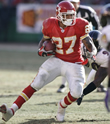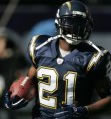7/26/07
Entering the early stages of the '07 fantasy football season, many
owners are piecing together their rankings and projections. To help
with the RB evaluation process, here is a study of "RB Studs,"
and how they perform the year after carrying a heavy workload the
previous season. What percentage of these "bell cow backs,"
continue to put up big numbers? Shaun Alexander, Tiki Barber, Edgerrin
James were all big RB producers two years ago, and for the most
part dropped off in ‘06. What can we expect from ‘06
studs like Larry Johnson, Steven Jackson, or Ladainian Tomlinson
in ‘07? In order to answer these questions, let’s go
back in time and take a look at other RBs with similar heavy workloads
and see how they produced the following year.
To analyze the relationship between the number of carries in a given
season and production the following year, we need some standards.
We obviously need the total number of carries for each RB, but we
also need to factor in receptions. Let's make things simple and
go with the following equivalencies:
1 carry = 1 carry
1 reception = .5 carry
The rationale for the reception equivalency is receptions still
account for “wear and tear,” but less so than carries.
With a rushing attempt, it is more common for several players
to tackle a RB and those players are often bigger and stronger,
defensive linemen and linebackers. I used these equivalencies
as the basis for my research and will refer to that total of these
two types of attempts as f/carries—formulated carries.
We also need to define what constitutes a "Heavy Workload,"
for a RB. I tried several different numbers for this formula and
settled on 370 f/carries as the benchmark. It netted
30 RBs who reached 370 f/carries a grand total of 45 times over
past 27 years. The following are an update of last season, the
results of data, my own conclusions, and which RBs could be impacted
in ‘07.
Recent Seasons
Here are results for running backs that attained the benchmark
carries in the ‘05 and how they performed the following
year.
| RB Workloads 2005-2006 |
| Player |
Years |
F/Carries
Yr 1 |
Fpts
Yr1 |
F/Carries
Yr2 |
Fpts
Yr2 |
Change |
Gms Missed |
| Edgerrin James |
'05-'06 |
382 |
267 |
356 |
172 |
-0.356 |
0 |
| Tiki Barber |
'05-'06 |
384 |
305 |
356 |
242 |
-0.207 |
0 |
| Shaun Alexander |
'05-'06 |
378 |
363 |
258 |
135 |
-0.628 |
6 |
| Average |
|
381 |
312 |
323 |
183 |
-0.4 |
3 |
|
There weren’t many players who reach this benchmark, but for
those that did saw a decrease in fantasy production. Each player
had a decrease in carries/receptions, a decreased ff production,
or missed time. This is actually quite indicative of the overall
historical trend and data for backs after attaining at least 370-f/carries
in a season.
Here’s a more historical perspective that includes the above
RBs in the overall data:
Games Missed For RBs Coming Off A 370-F/Carry
Season
For comparison I looked at the top 30 fantasy runners over the past
10 seasons. There were 108 backs (a total of 36.0% of the 300 backs
sampled) that missed at least one game during a given season. The
likelihood of a back reaching the heavy workload benchmark is significantly
higher in his following season:
- 25 of 45 (55.5%) Heavy Workload RBs missed at least 1 game
- 12 of 45 (26.6%) Heavy Workload RBs missed 1-3 games
- 13 of 45 (28.8%) Heavy Workload RBs missed 4+ games
What It Means: The data suggests
that RBs coming off a 370-f/carry season are more likely to miss
time due to injury than a typical RB in a given year. They are over
1.5 times more likely to miss 1 game (55.5% vs. 36.0%) and nearly
as likely to miss over 4 games as the rest of the sample was to
miss a single game.
F/Carries And Injury For Rbs Coming Off
A 370-F/Carry Season
Here are the ten-year totals for f/carries the season after a
RB attains the heavy workload f/carry benchmark:
- 7 of 45 (15.5%) RBs had an increase in f/carries (In fact,
the increase was a significant gain of +17.2 f/carries)
- 38 of 45 (84.4%) RBs had a decrease in f/carries
- RBs that missed at least a game had an average decrease of
–87.6 f/carries for the season
- Even if the RB didn’t miss a game the overall workload
decreased by an average of –29.2 f/carries
Overall, 22 of 28 (78.5%) RBs that didn’t miss a game
in the season after they reached the heavy workload benchmark
experienced a decrease in f/carries.
What It Means: RBs coming off
a season where they attained the heavy workload benchmark of 370
f/carries experienced a decreased in f/carries more than 8 out of
10 times—even when remaining healthy. When doing projections
or rankings of the top tier backs it’s useful to consider
this data. The difference may seem nominal even if you deduct just
24.8 f/carries from a 370-f/carry back for this year—a conservative
estimate—but it will likely yield more accurate projections
for your draft.
RB Fantasy Production Following A 370-F/Carry
Season
During the past twelve seasons, an overwhelming majority of heavy
workload backs from the previous year see a drop in production.
Here’s the breakdown:
| Dropping Like Flies |
| Production Change |
Total Rbs |
Met Criteria |
Pct. Of Rbs |
Resulting Fantasy Production |
| Same or better |
45 |
7 |
15.5% |
At least 300 fpts |
| Drop of 1%-10% |
45 |
5 |
11.1% |
270-299 fpts |
| Drop of 11%-20% |
45 |
2 |
4.4% |
240-269 fpts |
| Drop of 21%-30% |
45 |
12 |
26.6% |
210-239 fpts |
| Drop of 31%-40% |
45 |
6 |
13.3% |
180-209 fpts |
| Drop of 41%-50% |
45 |
6 |
13.3% |
150-179 fpts |
| Drop of over 50% |
45 |
7 |
15.5% |
At most 149 fpts |
|
What It Means: Only 12 of 45
(26.6%) running backs either met or experienced only a slight
decrease (10% or less) in their previous season’s production.
In contrast, 33 of 45 (73.4%) backs during that same period of
time experienced at least a 20% decrease in their fantasy production.
Future Career FF Production Of A 370 F/Carry
RB
Once a RB has a heavy workload season (370 f/carries), what can
we expect from him the rest of his career? Again, we'll turn to
historical data where there have been a total of 144 seasons that
occurred after these 45 backs posted a heavy workload year. This
should give us an idea of whether the RB has reached his peak
after such a big year.
| Future Career Production |
| Production Change |
Total Rbs |
Met Criteria |
Pct. Of Rbs |
| 200 fpts |
144 |
107 |
74.3% |
| 200-249 fpts |
144 |
19 |
13.1% |
| 250-299 fpts |
144 |
10 |
6.9% |
| 300-349 fpts |
144 |
4 |
2.8% |
| 350+ fpts |
144 |
3 |
2.1% |
|
What It Means: Only 4.9% of backs
ever attained 300+ fpts again once they already produced at 370-f/carry
season (approximately 2100 total yds/15tds). Even when you lower
the expectations to 250+ fpts (1700 total yds/13tds) the number
only rises to 11.8%. You actually have to considerably lower your
expectations to 200 fpts (1500totyds/8tds) just to see 1 out of
4 (25.0%) heavy producers ever reach that workload again.
Even more startling is you can count the number of players that
repeatedly reached the highest levels of RB fantasy production
on one hand! Emmitt Smith alone was responsible for three of the
seven seasons with 300+ points. And of the ten times where backs
reached the 250-299 point-mark more than once, seven of these
seasons came from three players: Walter Payton (3), Curtis Martin
(2), and Eric Dickerson (2).
Conclusions
RBs coming off 370-f/carry seasons have a lot of statistical data
working against them. But we Fantasy Footballers have heard similar,
and discouraging data before: "5 of 10 players will fall
out of top10 each year," and "‘WRs do poorly their
first year with a new team." What’s important to note
is that these statistics deal in probabilities and are not infallible
from year to year.
Yes, 5 backs may drop out of top 10 in a given year. But next
year it may be 3, the year after that could be 6, and then only
be 3 again for the following season. The point of such data is
not to say, "Don’t draft last year’s top RB(s)
coming off a 370-f/carry season," but to consider the data,
and be aware of the probabilities working against you when drafting
one of these players. Watch and note a player’s team and
individual situation and adjust draft strategy or rankings/projections
accordingly.
It’s rare to have a 370-f/carry season and even more rare
for a RB to repeat the feat. Most of the time there is nowhere
for an RB to go but down after a 370-f/carry season. It’s
not that these RBs always come back with bad years—but they
too often fail to live up to expectation. You should consider
that statistical history says it’s highly unlikely for RBs
coming off 370 seasons to attain a similar number of f/carries.
If you account for that in your projections and rankings, you
may find a more realistic view of the RB landscape
In summary, here are some important points to get from this study:
- Only 5.5% of the time in recent history has there been a
heavy workload season. (45 RB seasons out of 807).
- Only 15.5% of those 45 seasons has a RB met or exceeded his
f/carries after reaching that magical number of 370 f/carries.
- 55.5% of these RB missed games after hitting that threshold
in the previous year.
- 28.8% of these RB’s missed at least 4 games opposed
to the entire range of starting quality RBs in a ten-year period
that only missed a game 36.0% of the time.
Fantasy owners often say “last year’s stats are last
year’s stats.” This information as it applies to running
backs adds relevance to this cliché. Do not assume that most
RBs will meet or increase their f/carries and continue their heavy
workload. Adjust your draft strategy and rankings/projections accordingly.
If you draft a RB coming off a 370-f/carry season, you may want
to get the backup (handcuff) and/or draft running back reserves
early. The historical data indicates you have a 1 in 2 chance of
needing them for 1-3 games, and a 1 in 4 chance you will need them
for at least 4 games.
Of all the information gathered from this analysis the future
career production from an RB after reaching the 370-f/carry-threshold
is arguably the most telling. "Not wanting to miss out on
a big year," shouldn’t be your rationale for ignoring
this data. Big year’s (300+ FF pts) following a heavy workload
season haven’t happened that often—just 7 times out
of 144 opportunities—a whopping 4.9% occurrence. What’s
worse is three of them were from the NFL’s all time leading
rusher and most prolific FF player. Further, what would be considered
FF production validating a top-12 pick (around 250+ FF points,
1700 total yds/13tds) has happened just 17 times out of 144 opportunities
(11.8%). Those are long odds for a player to achieve your expectations
when he will likely cost you a high first round pick in your FF
drafts.
Who Are We Talking About In ‘07?
Okay, let’s ‘get down to brass tacks’ as they
say…who are we talking about in ‘07? Some fantasy
footballers are expecting productive years from the following
players who at one time reached the 370-benchmark:
- Ahman Green
- Jamal Lewis
- Deuce McAllister
- Edgerrin James
- Shaun Alexander
The historical data suggests there is a 74.3% chance (107 of 144)
that these players will not even attain 200 fpts (1500 total yds/8tds)!
Last year Ahman Green and Deuce McAllister were among these RBs
who attained the 370-benchmark in 2005 and were on this list.
Although both performed up to standards as a starting #2 FF RB,
neither attained 200 ff points (Green 172 ff points, McAllister
184 ff points) and performed consistently this tendency. So again,
not to say ‘do not draft these players, period’, just
consider the data and the cost, value, odds of success when drafting
them.
The RBs listed below had 370-f/carry seasons last year and are
among the consensus top-3 picks in most leagues. I want to reiterate
the point of this collected data and analysis: It is not to say
conclusively that you shouldn’t draft a RB coming off a
370-f/carry season, but consider the data and be aware of the
odds when drafting one of these players. Watch and note a player’s
team and individual situation, and adjust draft strategy or rankings/projections
accordingly.
For example, last year, in one of my league’s Alexander
fell to me at the #3 pick. I did not receive trade offers for
the pick or for Alexander that I liked during draft. So, despite
this data I personally collected and analyzed, I did pick Alexander.
Because, considering his value at the 3rd pick, would have been
a waste to do otherwise. I then ‘watched his individual
situation closely’. When he failed to do well early in season,
I saw it as a sign that other factors were pointing toward a down
year for Alexander. So I traded him before his injury for solid
value at that point in season.
Here are the backs that reached the 370-f/carry, threshold last
year:
 Larry
Johnson 416 carries / 41 recs = 437 f/carries Larry
Johnson 416 carries / 41 recs = 437 f/carries
Attaining a 400-f/carry season does not bode well for Johnson.
Attaining an actual, 400-carry season is even worse. Only 3 of
19 times (15.7%) has a RB coming off a 400-f/carry season met
or only slightly decreased in ff production. Only 1 of 4 RBs (25.0%)
had a productive FF season after a 400-carry season, the other
3 RBs never attained anywhere close to the same level of production
prior to their 400-carry seasons and they missed a total of 21
games between them the year after (Eric Dickerson, Jamal Anderson,
and Eddie George). Add the recent ‘hold out’ talk
surrounding Johnson and he is likely to fall significantly short
of expectations. If you draft Johnson, I strongly suggest picking
reserve RBs earlier and to pick Michael Bennett in latter rounds.
 Steven
Jackson 346 carries / 90 recs = 391 f/carries Steven
Jackson 346 carries / 90 recs = 391 f/carries
Jackson is an intriguing case. His receptions totals put him in
company with M.Faulk, P.Holmes, L.Tomlinson, but his 346 carries
are actually on the low end for RBs who meet the 370 benchmark.
Of the 12 times that a RB met or only slightly decreased in FF
production, 8 of the times were done by players in their first
1-3 years in NFL (66.6%) These players included Ladainian Tomlinson,
Edgerrin James, Terrell Davis, Emmitt Smith, and Eric Dickerson.
Jackson is going into his 4th year, but shared carries with Faulk
early on so his actual total of f/carries is comparable to those
8 RBs. Considering this information, his talent, the Rams scheme
and offense, I think Jackson has best chance from this group to
meet or just slightly decrease in production in ’07. Still,
I will err on side of caution and suggest that if you do take
Jackson, that you also pick Travis Minor and rookie Brian Leonard
in the later rounds.
 LaDainian
Tomlinson 348 carries / 56 recs = 376 f/carries LaDainian
Tomlinson 348 carries / 56 recs = 376 f/carries
As most of us have seen, Ladainian Tomlinson is a physical specimen
with superior talent, vision, and athleticism. He is the centerpiece
of a prolific offense on an up and coming team. He is coming off
a record-breaking 31-touchdown season, one of the best in FF or
NFL history. With 1800 total yds and 19 tds per season over a
6-year career, places him among the all-time FF elite.
So, what’s not to like? Well, Tomlinson has now attained
the 370-mark twice: His 2nd year in the league and last year.
In three other seasons, he just missed the 370-benchmark, reaching
the high 360’s. His 2200 career f/carries is comparable
to where such RBs as Marcus Allen, Thurman Thomas, and Emmitt
Smith ‘fell off’ significantly in production. How
long do the elite RBs remain elite before dropping off considerably?
- Shaun Alexander—5 years
- Priest Holmes—4 years
- Marshall Faulk—4 years
- Terrell Davis—3 years
- Emmitt Smith—5 years
Tomlinson already has 5 straight seasons that would qualify as
FF elite. With all that said, I do project a decrease in production
for Tomlinson, to as much as 20%-30%. Remember, Tomlinson scored
417 FF points last year. So a 20% decrease would put him at about
320 FF points—2000 total yards and 20 scores. A 30% decrease
would put him at about 280 FF points—1900 total yards and
15 scores. Both estimates are still very good production for a
back. Still, protect your investment in Tomlinson and grab Michael
Turner in later rounds.
|

